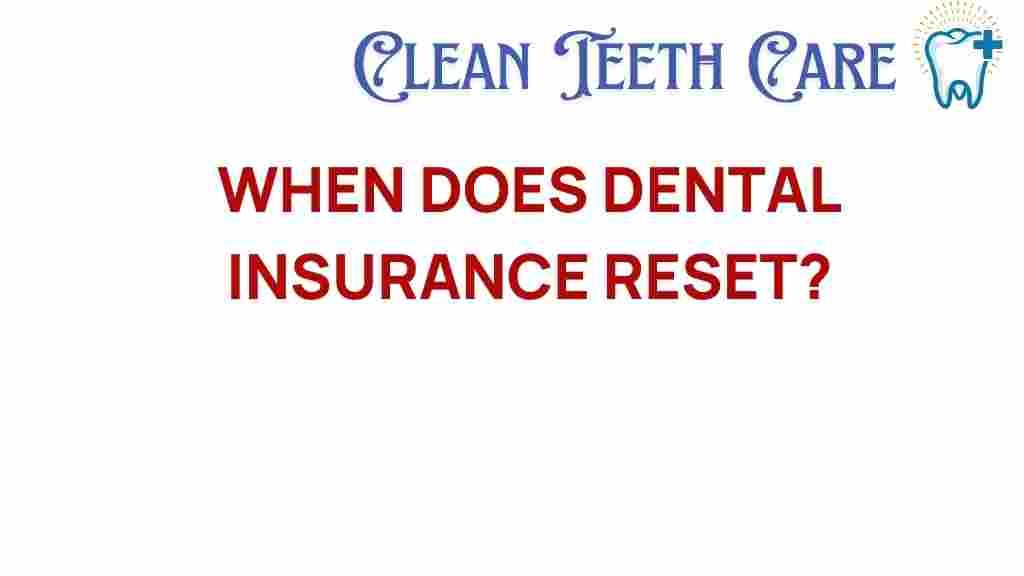Unraveling the Mystery: When Does Dental Insurance Reset?
Understanding dental insurance is essential for anyone seeking to maximize their benefits and coverage. Many people wonder when their dental insurance resets and how it affects their access to dental care. In this article, we will explore the intricacies of dental insurance, including the timing of policy renewal, the nature of benefits, and reimbursement processes. By the end, you’ll have a clearer picture of how to navigate your dental insurance effectively.
The Basics of Dental Insurance
Dental insurance is a type of health insurance designed specifically for dental care. It typically covers a range of services, from routine check-ups to more extensive procedures. Understanding the basic structure of a dental insurance policy can help you make informed decisions about your dental care.
- Types of Plans: Most dental insurance plans fall into two categories: indemnity plans and managed care plans (like PPOs and HMOs).
- Coverage: Dental insurance usually covers preventive services, basic procedures, and major procedures at varying percentages.
- Annual Maximum: Most dental insurance policies have an annual maximum limit, which is the maximum amount the insurer will pay for covered services in a policy year.
When Does Dental Insurance Reset?
Dental insurance typically operates on a calendar year basis, meaning that it resets on January 1st of each year. However, some policies may have different renewal dates, depending on the insurer. Understanding the reset timing is crucial for planning your dental care effectively.
Policy Renewal and Its Impact on Benefits
When your dental insurance policy renews, there are several factors to consider:
- Benefit Restoration: At the start of each policy year, your benefits reset. This means you have access to the full range of services covered by your plan from day one.
- Unused Benefits: If you do not use all your benefits by the end of the policy year, they usually do not roll over into the next year.
- Changes in Coverage: Some policies may change their coverage terms upon renewal. It’s essential to review your policy details each year.
Understanding Your Coverage
Your dental insurance coverage can significantly influence your dental care decisions. Here are a few critical elements to understand:
- Preventive Care: Most plans cover preventive care, such as cleanings and exams, at 100%. Regular visits can help you maintain good oral health and catch issues early.
- Basic Procedures: These may include fillings and extractions, typically covered at a lower percentage (e.g., 70-80% after deductibles).
- Major Procedures: Crowns, bridges, and dentures can be more expensive and may only be covered at 50% after the deductible.
Timing Your Dental Care
To maximize your dental insurance benefits, timing is crucial. Here are some tips to help you schedule your dental care:
- Plan Ahead: Schedule your routine check-ups and cleanings early in the year to ensure you utilize your benefits effectively.
- Emergency Procedures: If you need more extensive dental work, consider timing it toward the beginning of the policy year to take advantage of your full coverage.
- End-of-Year Rush: Many people rush to use their benefits before the year ends, leading to longer wait times. Plan accordingly to avoid this.
Reimbursement Process
Understanding how reimbursement works with your dental insurance can help you avoid unexpected costs:
- Direct Billing: Some dentists offer direct billing, meaning they will submit claims to your insurance company on your behalf.
- Out-of-Pocket Expenses: If your dentist does not bill your insurance directly, you may have to pay upfront and then submit a claim for reimbursement.
- Documentation: Always keep copies of your receipts and any relevant documents for reimbursement purposes.
Troubleshooting Common Issues
Even with the best planning, issues can arise with dental insurance. Here are some common problems and how to address them:
- Claim Denials: If your claim is denied, review the explanation of benefits (EOB) carefully. Contact your insurance provider for clarification.
- Unexpected Costs: If you receive a bill that is higher than expected, check if your dentist submitted the claim correctly and if the services were covered under your plan.
- Changes in Coverage: If your dental insurance plan changes, make sure to understand how it affects your current providers and covered services.
Conclusion: Making the Most of Your Dental Insurance
Dental insurance can be a complex area, but understanding when your policy resets and how to navigate its benefits is crucial for maintaining your oral health and managing your costs. By planning your dental care strategically, staying informed about your coverage, and being proactive about reimbursement, you can effectively utilize your dental insurance.
For more information about dental insurance options and to find a plan that suits your needs, you can visit this resource.
Remember, the key to a healthy smile is not just in the care you receive but also in how well you understand and utilize your healthcare benefits. Take the time to familiarize yourself with the details of your dental insurance policy, and don’t hesitate to reach out to your provider with questions or concerns.
This article is in the category Treatments and created by CleanTeethCare Team
